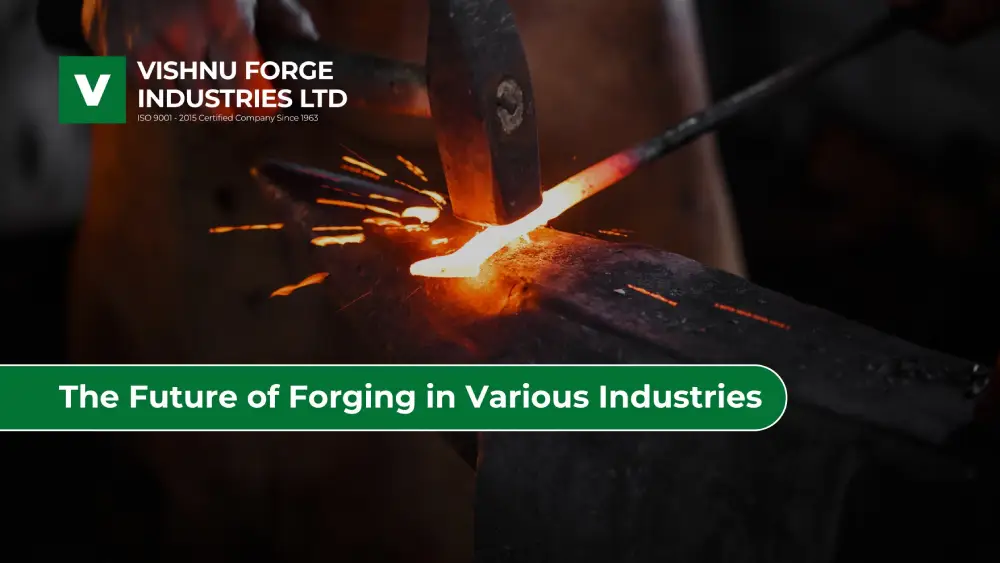Introduction to Forging and Its Industrial Importance
It has been a backbone of industrial manufacturing, known for creating forged components that offer unmatched strength, durability, and reliability. Through high-pressure shaping of metal, it enhances structural integrity, making it ideal for sectors that require resilient parts. Industries like automotive, aerospace, oil and gas, and construction depend on these high-performance components. As new technologies emerge, the future of forging is transforming, focusing on sustainable and efficient production to meet evolving industry standards.
Advancements in Forging Technology
Innovations in Precision
Precision forging has raised the standard for quality and accuracy in industrial forging applications. This advancement allows manufacturers to create parts with detailed geometries and strict tolerances, catering to demanding sectors.
Automation and Robotics in Processes
The adoption of automation and robotics in forging is reshaping production, minimizing human error and maximizing efficiency. This transformation supports higher volumes without compromising quality, a key development for industries with mass production needs.
The Role of Digital Simulation and AI
Digital simulation and AI in help manufacturers forecast and optimize outcomes by modeling heat flow, pressure, and deformation. This predictive approach is streamlining operations, furthering efficiency, and improving the consistency of forged parts.
The Motor Manufacturing Industry: Forging for Lighter, Stronger Components
Demand for Lightweight Forged Parts
In the Motor manufacturing industry, lightweight forged components are in high demand, as they enhance fuel efficiency and help lower emissions. The processes now adapt to aluminum and magnesium alloys, which are ideal for producing strong yet lightweight automotive parts.
Improved Safety and Performance in Motor manufacturing
Motor manufacturing is critical for creating parts like gears, crankshafts, and suspension components, where strength and reliability are essential. Advances in motor manufacturer have enhanced these parts’ resilience, leading to safer, high-performance vehicles.
Eco-Friendly Materials and Processes
Sustainability is becoming central in Motor manufacturing, with a shift toward recyclable and eco-friendly materials and more energy-efficient processes. This aligns with the industry’s goal to promote greener production practices.
Forging in the Aerospace Sector: Meeting High-Performance Demands
The Need for High-Strength, Heat-Resistant Components
The aerospace industry relies on forged components that can withstand extreme temperatures and stresses. Forged parts, such as turbine discs and structural components, are essential to meet the high-performance needs of aviation.
Forging Materials for Aerospace: Titanium and Aluminum Alloys
Titanium and aluminum alloys are favored in aerospace due to their strength-to-weight ratios. These lightweight yet robust materials are ideal for aerospace parts, ensuring the durability and reliability required in flight.
Future Trends in Forging for Aerospace Applications
Future trends in aerospace include adopting new materials and manufacturing techniques, further reducing weight and improving efficiency to meet the growing demands of the aerospace sector.
Oil and Gas Industry: Forging’s Role in Extreme Environments
Requirements for Corrosion-Resistant and Durable Components
In the oil and gas industry, produces corrosion-resistant and durable components capable of withstanding high temperatures, pressures, and corrosive substances. This durability extends the lifespan of equipment and enhances operational safety.
Forging Techniques for High-Pressure, High-Temperature Parts
The techniques are tailored to create components that endure high pressures and temperatures, essential for oil and gas parts like valves, flanges, and connectors that operate in demanding environments.
Innovations in Sustainable Forging for Oil and Gas
Eco-friendly processes and materials are gaining importance in the oil and gas sector, supporting industry-wide sustainability initiatives by reducing waste and environmental impact.
The Construction Sector: Forging’s Contribution to Structural Integrity
High-Strength Forged Components in Construction
Forged components, such as forged steel beams and connectors, are crucial in construction for providing strength to large structures like buildings and bridges. These components enhance structural integrity and resilience.
Forged Steel in Earthquake-Resistant Buildings
In construction contributes to earthquake-resistant building design, as forged steel’s flexibility and strength help structures absorb and dissipate seismic forces, reducing the risk of collapse.
Sustainable Forging for Construction Applications
The construction industry is shifting towards sustainable, using processes that minimize waste and energy consumption. Forging’s eco-friendly approach aligns with green building practices.
Medical Field: Forging High-Precision and Bio-Compatible Components
Application of Forging in Medical Device Manufacturing
It is essential in medical manufacturing, creating precise, high-strength components used in surgical instruments, implants, and diagnostic devices, where accuracy and durability are paramount.
Materials Used in Forging for Medical Components
Bio-compatible materials like stainless steel and titanium are prominent in medical, ensuring safety and corrosion resistance, making them suitable for long-term implantation.
Future Trends: Customization and Miniaturization in Medical Forging
Future advancements in medical focus on customized implants and miniaturized devices, supporting less invasive procedures and improved patient outcomes.
Renewable Energy: Forging Components for Sustainable Solutions
Forging’s Role in Wind, Solar, and Hydro Energy Systems
Forged parts are vital in renewable energy, supporting the structural needs of wind turbines, solar arrays, and hydroelectric systems. Forged components offer the strength and resilience required for long-term, sustainable energy production.
Specialized Materials for Forged Components in Renewable Energy
High-strength steels and corrosion-resistant alloys are key in renewable energy, providing the longevity and durability necessary for components exposed to harsh outdoor conditions.
Innovations for Longevity and Efficiency in Forged Energy Parts
Advanced for renewable energy focuses on enhancing part longevity and efficiency, aligning with the increasing demand for sustainable energy solutions.
Environmental and Economic Benefits
Reduced Material Waste and Energy Efficiency in Forging
It is inherently energy-efficient and produces minimal waste, making it an ideal process for sustainable manufacturing. These benefits are crucial as industries seek to reduce their environmental impact.
Cost-Efficiency in Mass Production Through Forging
It offers cost-effective solutions for large-scale production, maintaining high-quality output at lower costs, which is beneficial for industries with mass production requirements.
The Role in Sustainable Manufacturing
It minimal waste and energy efficiency position it as a valuable process in sustainable manufacturing, with a focus on future innovations that balance environmental impact with industrial performance.
Conclusion: The Expanding Horizons Across Industries
It remains fundamental across various industries, from automotive to aerospace, medical, and renewable energy. As forging technology advances, it will meet the increasing demand for sustainable practices that address the challenges of tomorrow. The future of forged components in high-performance applications promises continued innovation, supporting industries with both environmental and industrial goals at the forefront.



